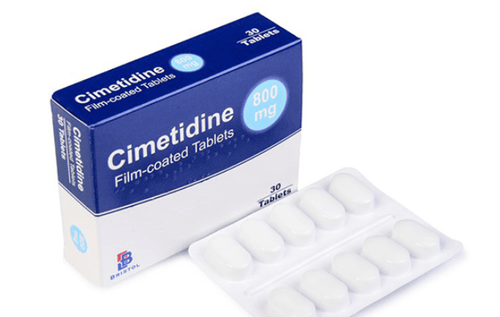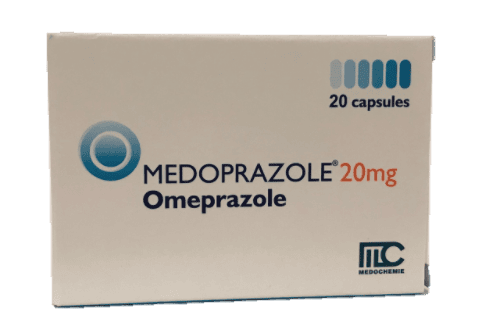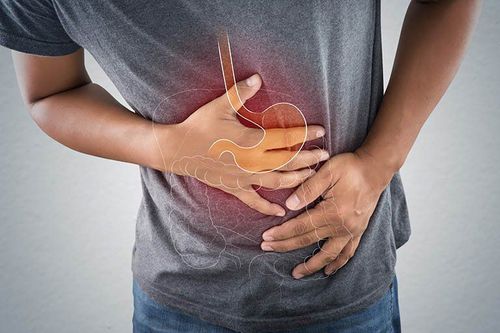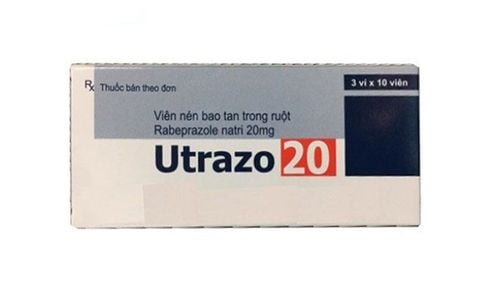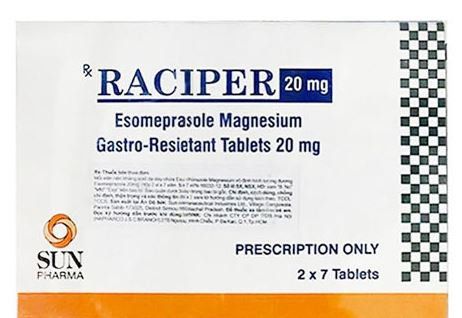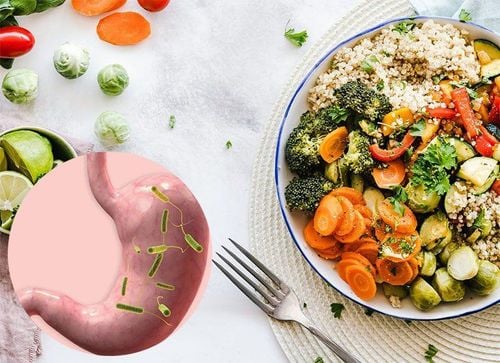This is an automatically translated article.
Gastroesophageal reflux disease (GERD) is a disease manifested through symptoms such as heartburn, regurgitation, difficulty swallowing ... caused by gastric juice backing up into the esophagus. Currently, there are many methods or tips to treat gastroesophageal reflux disease very effectively without using drugs, they are considered as supportive treatment measures for this disease.
1. What is Gastroesophageal Reflux?
Gastroesophageal reflux disease is a disease caused by excessive reflux of gastric juice into the esophagus causing symptoms and complications on the esophagus. In fact, after a meal, there is still a small amount of acid from the stomach backing up into the esophagus, but this is a normal physiological phenomenon.
In the upper gastrointestinal tract, the esophagus will be protected by the action of the upper esophageal sphincter, but more importantly, the lower esophageal sphincter and peristalsis of the esophagus. These physiological structures and functions help the esophagus avoid contact with substances such as food, gastric juice, etc., that reflux from the stomach. However, when the body is exposed to risk factors, these protective mechanisms weaken and gradually develop gastroesophageal reflux disease (GERD).
Causes of this condition are:
Continuous decrease in pressure or temporary relaxation of esophageal sphincter muscles Weak esophageal peristalsis is not enough to push refluxed substances from the stomach down. After surgery in the esophagus. Diaphragmatic hernia. Conditions of increased gastric acid secretion, delayed gastric emptying, stagnation of food, increased pressure in the stomach or abdomen. Helicobacter pylori (HP) infection. Stress, anxiety, prolonged stress. Taking Non-Steroidal Anti-Inflammatory Drugs (NSAIDs), Steroids, Aspirin, Calcium Blockers, Beta Blockers for Asthma, Theophylline, Anticholinergics, Nitrin, Some Hormonal Medicines (Progesterone), Antidepressants, Medicines sedation... Frequent use of alcohol, carbonated drinks. Smoke. Limit physical activity, inactivity. Overweight and obese patients. Pregnant women. The disease is familial.
2. Diagnosis of gastroesophageal reflux disease
Possible clinical diagnosis of gastroesophageal reflux disease with esophageal and extraesophageal symptoms: Esophageal symptoms: heartburn, regurgitation, dysphagia, sleep disturbance (originating) from digestive disorders) Extraesophageal symptoms: chronic cough, bronchial asthma, laryngitis, recurrent pharyngitis, lobar pneumonia, pneumonia caused by aspiration of food or gastric juices, tooth erosion, Non-cardiac chest pain... Subclinical diagnosis by methods: X-ray of the esophagus with contrast to find lesions such as esophageal ulcers, esophageal cancer ... Endoscopy Gastroduodenal : Used to evaluate esophageal mucosal status and other complications in patients with gastroesophageal reflux disease. Esophageal manometry (measurement of esophageal peristaltic pressure) and 24-hour pH measurement are tests that are usually performed only for research purposes. Bernstein test. Esophageal biopsy to confirm the diagnosis of lesions.
3. Treatment of Gastroesophageal Reflux Disease (GERD)
3.1. Experience in treating gastroesophageal reflux disease without medication Change your diet
Maintain an appropriate weight to avoid increased pressure on the gastrointestinal tract. Limit greasy, fatty foods, sour dishes or fruits... Abstain from alcohol, coffee and carbonated drinks... Divide the menu into many small meals. Do not lie down immediately after eating or do not overeat during a meal. Lifestyle changes
Elevate your head when sleeping (10 – 15 cm) or use anti-reflux pillows when lying down to prevent symptoms of GERD. Avoid wearing clothes that are too tight. Avoid tobacco use. Gentle exercise, yoga, meditation, listening to relaxing music... Reduce anxiety, stress, stress. Tips to cure gastroesophageal reflux according to folklore
Baking Soda: This active ingredient has anti-inflammatory, antiseptic, helps to disinfect and clean the throat, neutralizes acid, reduces the burning sensation caused by reflux, copper. It also prevents bacteria or acid reflux from causing damage to the lining of the esophagus. Make a treatment with Baking Soda according to the following instructions: Ingredients: 1 teaspoon of Baking Soda and 200 ml of filtered water. Stir the mixture and drink 2-3 cups per day. Use for 7 days. Fresh turmeric and honey: In fresh turmeric contains Curcumin, the active ingredient that has a good effect in preventing ulcers, controlling inflammation and protecting the stomach lining. Make the treatment with fresh turmeric according to the following instructions: Ingredients: 1 fresh turmeric root and 1 tablespoon honey. Peel the turmeric root, wash it and let it dry. Put in a mortar or blender to pound or puree. Mix the mixture with 100 ml of warm water with 1 teaspoon of honey. Use the mixture regularly before eating 15-30 minutes. Garlic and honey: These two foods contain many substances that have the effect of protecting and repelling the attacking bacteria that cause gastroesophageal disease. Do the treatment with garlic and honey according to the following instructions : Ingredients : 500 g of garlic and 300 ml of pure honey. Peel the garlic and smash it. Use a glass jar to store crushed garlic then pour honey on top. Cover tightly and use within 3 weeks. Continuously use 2-3 cloves of garlic soaked in honey every day before or after meals. Apricot leaves: This ingredient has antiseptic and detoxifying properties, and helps neutralize stomach acid and strengthen the digestive system. Perform treatment with apricot leaves according to the following instructions : Materials : 200 g of apricot leaves. Rinse then let dry. Put in a mortar or blender to pound or puree. Strain the juice and discard the apricot leaves. Use directly or steam before use. Use apricot leaf juice 2 times per day. Betel leaf: This material has the effect of regulating and balancing PH levels, healing wounds, and preventing the growth of bacteria that cause reflux. Make treatment with betel leaves according to the following instructions: Ingredients: 10 betel leaves and 1 teaspoon of salt. Wash betel leaves and soak them in diluted salt water. Put betel leaves in 300 ml of water and boil for 15 minutes. Strain the juice and discard the betel leaf residue. Use 1 hour before lunch. Green bananas: Green bananas contain minerals, fiber and vitamins that help fill the mucosal layer, reduce damage, and fight inflammation. Do the treatment with green bananas according to the following instructions: Ingredients: 2 green bananas and 1 teaspoon of granulated salt. Peel the banana peel and soak it in salted water. Take out and let dry. Cut bananas into thin slices and soak in salted water for 15 minutes. Take pickled bananas and eat with rice for 3-4 times per week. Turmeric starch: Use in combination with honey or mix with warm water and use directly. Aloe vera: This material contains many antioxidants that help fight inflammation, prevent the attack of free radicals and protect the stomach lining. Make the treatment with aloe vera according to the following instructions: Ingredients: 5 branches of aloe vera, 5ml of honey and 1 teaspoon of granulated salt. Peel the green skin of aloe vera then soak it in dilute salt water for 10 minutes. Put in a mortar or blender to pound or puree with honey. Add 500 ml of warm water to the above mixture and store in the refrigerator. Use 2 scoops per day. Coconut water: This ingredient contains active ingredients Lauric Acid and vitamins to help eliminate the virus that causes reflux, strengthen the body's resistance and immune system. Use coconut water directly or boil to make the active ingredients easily absorbed into the body. Guava leaves: This material contains many active ingredients such as Flavonoid, Tanin, Saponin... has antibacterial and anti-inflammatory effects. Perform treatment with guava leaves according to the following instructions: Materials: 50 g young guava leaves, 200 g brown rice and 500 ml filtered water. Wash guava leaves, take out to dry. Finely chop guava leaves, stir-fry with brown rice. Add filtered water and simmer until the water boils. Strain the residue to get the juice. Use the mixture while it is still warm so that the active ingredients are easily absorbed into the body. 3.2. Drug treatment 3.2.1. Proton pump inhibitors (PPIs) are the most commonly used drugs that block gastric acid secretion. Commonly used drugs such as Omeprazole, Pantoprazole, Esomeprazole, Rabeprazole, Lansoprazole, Dexlansoprazole...used about 30 minutes before eating. Treatment usually lasts from 4 to 12 weeks.
3.2.3. Acid and Alginate Neutralizing Drugs Commonly used gastric acid neutralizing drugs are drugs containing aluminum salts and magnesium salts such as Maalox, Alusi, Gastropulgite...Alginate is the active ingredient that helps to create a neutral plaque to prevent reflux, the drug Commonly used: Gaviscon.
The above drugs are usually taken 1 to 3 hours after eating.
3.2.5. Histamine H2 receptor antagonists Some commonly used drugs such as Zantac, Ranitidine, Tagamet... Use food for about 15 to 30 minutes.
3.2.4. Prokinetics are commonly used in combination with proton pump inhibitors (PPIs) in the treatment of gastroesophageal reflux disease. Commonly used drugs such as Metoclopramide, Domperidone, Baclofen...
3.3. Surgical treatment Surgical or endoscopic intervention is indicated when the patient does not respond to medical treatment or when the patient does not want to take the drug for a long time.
Current popular treatment methods such as:
Endoscopic intervention: Suture the lower esophageal sphincter. Nissen esophagectomy. Use a magnetic device to tighten the esophageal sphincter. Currently, there are many methods used to treat gastroesophageal reflux disease such as using drugs, surgical methods or remedies or methods based on folk experience. However, to ensure the safety and effectiveness of the treatment process, patients or their loved ones need to consult a specialist before deciding to use any treatment methods.
Please dial HOTLINE for more information or register for an appointment HERE. Download MyVinmec app to make appointments faster and to manage your bookings easily.




